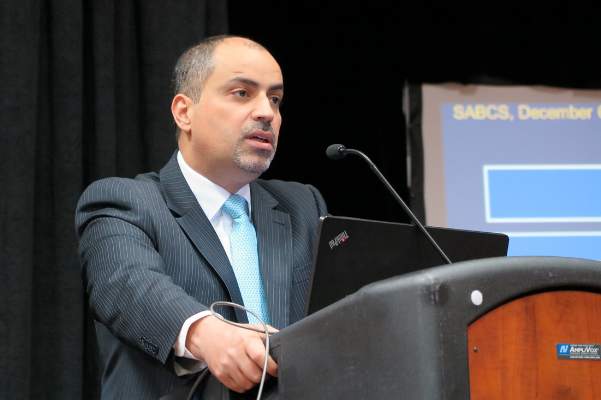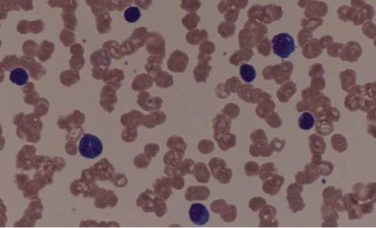AT SABCS 2016
SAN ANTONIO (FRONTLINE MEDICAL NEWS) – Although adding concurrent estrogen deprivation to a standard combination chemotherapy regimen for women with breast cancers positive for the estrogen receptors (ER+) and the human epidermal growth factor receptor–2 (HER2+) did not add to the already considerable toxicity, it also did not seem to add much benefit, according to an investigator in the NSABP B-52 trial .
Among 311 women with ER+/HER2+ tumors randomized to neoadjuvant therapy with docetaxel, carboplatin, trastuzumab (Herceptin), and pertuzumab (Perjeta) with or without estrogen deprivation therapy, there was no statistically significant difference in the primary endpoint of pathologic complete response (pCR) rates, reported Mothaffar F. Rimawi, MD, of the breast center at Baylor College of Medicine in Houston.
“Given the toxicity of standard chemotherapy observed in this trial, findings from NSABP B-52 quite strongly argue for a tailored de-escalation approach where toxic treatments are omitted or replaced with less toxic ones without compromising outcomes,” he said at the San Antonio Breast Cancer Symposium.
“I think the most important lesson from B-52 is that when we hit the tumors with everything we’ve got, this is what we have. We need to start thinking about whether we can, essentially, start dialing down these treatments. Can we omit one of the chemotherapy agents, if not both, and see what happens,” Dr. Rimawi said in an interview.
Endocrine/chemo interplay?
The rationale for the trial was based on several previous findings, including the propensity for ER+/HER2+ tumors to be less responsive to dual anti-HER2 therapy with trastuzumab (Herceptin) and pertuzumab (Perjeta).
There is also evidence to suggest that the estrogen receptor may act as a pathway of resistance to anti-HER2 therapy, and evidence from older trials suggested that chemotherapy and endocrine therapy may have antagonistic effects, he said.
The investigators hypothesized that concurrent inhibition of ER and HER2 tumors with neoadjuvant chemotherapy consisting of docetaxel, carboplatin, trastuzumab, and pertuzumab (TCHP) would not be antagonistic, and could overcome resistance to treatment as shown by improvements in pathologic complete response rates.
The investigators enrolled women with HER+ and ER+ and/or progresterone receptor–positive (PR+) invasive breast cancer diagnosed by core needle biopsy, stratified them by premenopausal or postmenopausal status, and then randomized them to receive chemotherapy with docetaxel, carboplatin, trastuzumab, and pertuzumab every 21 days for six cycles, with or without estrogen deprivation therapy. Postmenopausal women received an aromatase inhibitor, and premenopausal women received an aromatase inhibitor plus ovarian suppression with goserelin and a lutenizing hormone–releasing hormone agonist.
For the primary endpoint, overall rates of pCR in the breast and nodes were 41% among 154 patients treated with TCHP chemotherapy alone, vs. 46% for 157 women treated with TCHP and estrogen deprivation, a difference that was not statistically significant. The results were similar in an analysis stratified by menopausal status: 44% vs. 46%, respectively, in premenopausal women, and 38% vs. 45% in postmenopausal women. Neither comparison was statistically significant.
In addition, no overall or stratified differences were seen in terms of pCR in the breast alone, and no differences were seen in clinical complete response rates, at 68.1% vs. 73.9%, respectively.
Nearly 100% of patients in the TCHP chemotherapy alone arm had diarrhea, ranging from 42% with grade 1, to 34% with grade 2, to 23% with grade 3, to less than 1% with grade 4. The distribution of diarrhea severity was virtually identical among patients treated with TCHP plus estrogen deprivation, all of whom experienced some grade. Other common gastrointestinal side effects in each study arm included nausea, vomiting, and dehydration, occurring in nearly all patients with equal distribution of severity between the two arms.
Hematologic toxicities included anemia, hypokalemia, and febrile neutropenia, again distributed evenly in severity between the trial arms.
Alternative endpoint?
Dr. Rimawi said the pCR endpoint commonly used in clinical trials may not be ideal for studying therapy in this population, because it generally correlates with outcomes among women when tumors are ER negative,“but when they are ER positive, the absence of a pathologic complete response is not necessarily a bad thing.”
He said that residual cancer burden, or RCB, appears to be a better marker for prognosis than pCR in patients with ER+/HER2+ tumors.
“In this population we need a different metric, a metric that is not path CR,” agreed Carlos Arteaga, MD, professor of cancer biology and medicine, and coleader of the breast cancer research program at Vanderbilt-Ingram Cancer Center in Nashville, Tenn.
“We need other metrics that are more objective and more correlated with long-term outcomes. Path CR is not,” said Dr. Arteaga, who moderated a briefing where NSABP B-52 data were discussed prior to their presentation in the general session.
Regarding the lack of statistical significance, Dr. Rimawi said it is possible that the effects of chemotherapy may have blunted the responses that might otherwise have been seen with the addition of estrogen deprivation.
“We believe that if we de-escalate treatment, we could see a higher response to the estrogen receptor inhibitor,” he said.
NSABP B-52 was supported by the National Cancer Institute and Genentech. Dr. Rimawi reported contracted research from Genentech and GlaxoSmithKline. Dr. Arteaga reported no disclosures relevant to the trial.





